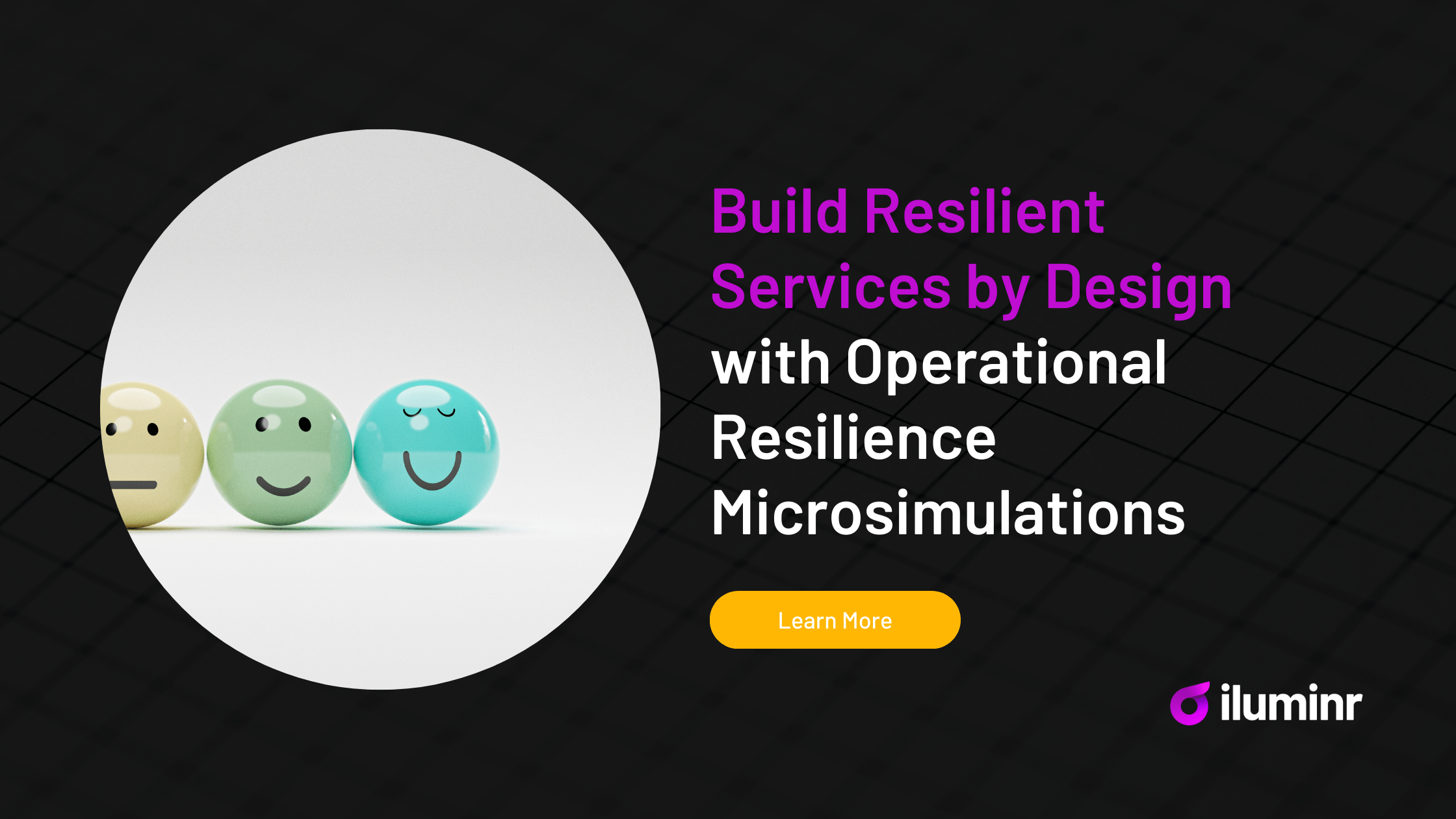iluminr recently had the privilege of sponsoring the GFMI Operational Resilience Conference in Boston, an event that brought together thought leaders and experts from across the industry to discuss the future of operational resilience.
There were 7 key takeaways from the conference, highlighting innovative strategies, critical discussions, and actionable insights aimed at enhancing the resilience of businesses in today’s complex and ever-evolving landscape.

1. Governance is a Catalyst
Governance is not just a checklist item but a strategic cornerstone essential for guiding businesses through both stability and innovation. Senior leaders need to dismantle the outdated notion that governance is merely procedural and recognize its role in protecting and enhancing the organization. They must look beyond compliance, creating a dynamic framework that encourages a culture of alertness and continual improvement.
Governance is an evolving process that adapts to new market trends, technologies, and business models. Governance should facilitate creativity, not stifle it, by interpreting rules in a way that aligns with the organization’s vision and values. Emphasizing the “art” of governance involves crafting policies that are ethical, practical, and aligned with long-term strategic goals.
2. Business Owns the Risk
Business must assume full ownership of their risk profiles, as comprehensive custodians of their operational footprints. This ownership is not merely about acknowledging risks but actively managing how business operations ripple through and affect the larger market and customer ecosystems.
In today’s interconnected global economy, the notion of risk extends well beyond financial metrics. It encompasses a wide array of factors. Organizations are called to weigh considerations such as concentration risk, which may arise from over-reliance on a single supplier or market, and the dependency chain, which refers to the interconnectedness of services and suppliers that could amplify the impact of a disruption.
This expanded view of risk ownership speaks to a more holistic understanding of an organization’s role in the wider world; every operational decision has the potential to affect not just the immediate business environment but also the broader market context in which the company operates.
Companies are adopting a more sophisticated, mature view of risk—one that acknowledges the complexities and interdependencies of the modern business landscape. By doing so, companies not only protect themselves but also contribute positively to the markets and communities they serve, enhancing their reputation and securing their place as responsible corporate citizens in an increasingly conscientious world.
3. The Elasticity of Capabilities
There is a delicate balance between stretching to meet ambitious goals and not snapping under pressure. Organizations must learn how to extend their capabilities without compromising their integrity or overreaching their operational limits.
This balance is critical, not just to avoid the immediate repercussions of failing to meet targets under pressure but also to safeguard the organization’s long-term health and reputation. Extending capabilities thoughtfully means strategically scaling operations, investing in new technologies, and entering new markets, all while maintaining a steadfast commitment to ethical standards and operational excellence. It’s a delicate maneuver that requires foresight to ensure that the push for growth does not compromise the foundational principles of the organization.
4. Scenario Testing is a Reflex
Scenario testing should be as natural as muscle memory. When it comes to disruption, it is not so much ‘if’ but the ‘when’. Organizations must regularly engage in scenario testing, moving beyond tabletop exercises to immersive simulations that test the robustness of their response plans. Crisis management is increasingly an ongoing necessity—not just a one-off event.
Integrating scenario testing into existing organizational habits and routines can significantly enhance both efficiency and realism, transforming it from a sporadic activity into a seamless aspect of daily operations. To achieve this, organizations can embed scenario-driven checkpoints into regular meetings, staff training sessions, and operational reviews. By aligning scenario testing with the natural rhythm of the business cycle, such as quarterly planning sessions or annual risk assessments, organizations ensure continuous engagement and familiarity with crisis protocols among all team members.
Leveraging real-time data and current events (a “ripped from the headlines” approach) to model scenarios ensures that these simulations are as realistic as possible, reflecting the actual challenges the organization might face. This methodical integration helps cultivate a culture of preparedness, where response strategies are not only rehearsed but are continuously refined and ingrained in the organizational psyche.
5. Resilience is Multidimensional
Operational processes are historically linear, but resilience demands a multi-dimensional approach. This involves changing the dynamics around resilience and shifting from one-way directives to a more interactive and responsive framework. The aim is to build muscle memory for agility and resilience.
To transform resilience into a dynamic and interactive capability, organizations must foster a culture where feedback loops and cross-departmental collaboration are integral. This means moving beyond traditional siloed approaches and enabling continuous communication between different facets of the organization. By involving diverse teams in resilience planning and scenario testing, insights from various perspectives are incorporated, enhancing the adaptability and effectiveness of response strategies. Such an approach encourages proactive problem-solving and allows the organization to respond more swiftly and adeptly to challenges. The goal is to not only prepare for potential disruptions but to also empower all parts of the organization to react with agility and confidence, turning resilience into a core organizational competency.
6. Design for (Operational) Resilience
It’s long been understood companies must have a defensible understanding of impact tolerance levels and design their operations to be robust within these thresholds. This involves conducting in-depth analyses to determine the maximum acceptable level of disruption for critical services and processes, and then engineering operations to withstand such impacts.
Embedding adaptive and flexible components in operational design—such as modular systems that can be quickly reconfigured or scaled depending on situational requirements—ensures that organizations are not only prepared to handle disruptions within their impact tolerance but can also quickly adapt to unexpected changes in the threat landscape.
7. Adaptation is the Goal
Arguably, the most vital aspect of operational resilience is constantly adjusting strategies based on real-world scenarios and integrating learnings into business operations. The idea that resilience is about the “days after building back up, not just the moment of crisis” points to the necessity for an ongoing strategy that evolves in response to new information and challenges.
In this context, the practice of continuous improvement in resilience strategies becomes crucial. Organizations must cultivate a dynamic approach to learning from both past incidents and near misses. This means not only conducting post-crisis analyses to identify what went right or wrong but also actively seeking out lessons from each simulated scenario to refine and strengthen resilience plans. By documenting these insights and integrating them into operational practices, companies can evolve their strategies to be more responsive to future challenges. This approach underscores the notion that resilience is a cyclical process of preparation, response, recovery, and improvement. It emphasizes that true resilience extends beyond immediate crisis management to include robust, ongoing enhancements that prepare an organization for the complexities of tomorrow’s operational landscape.
Operational Resilience: A Synthesis of Capability
In blending these takeaways from the GFMI Operational Resilience Conference, we’re reminded that operational resilience is a complex tapestry, woven from the threads of governance, risk management, market stewardship, and continuous adaptation. Businesses that integrate these principles into their operational DNA are those that will not only endure but also excel in the face of the unexpected.
To learn more about how iluminr can help you build business services that are more resilient by design, save your seat for our upcoming Product Masterclass.
Author
Paula Fontana
VP, Global Marketing
iluminr















